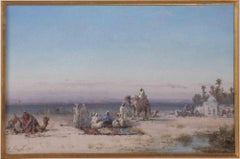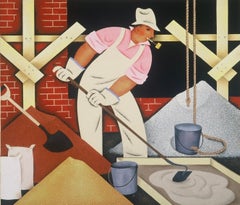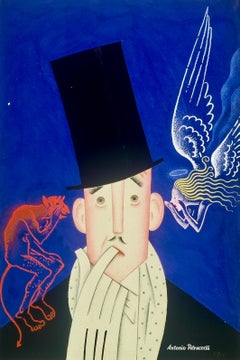Paul Pascal Figurative Paintings
to
1
Overall Width
to
Overall Height
to
1
1
1
1
1
1
1
3
468
322
258
227
1
Artist: Paul Pascal
Rest at the Caravanserail - Gouache by Paul Pascal - 1885
By Paul Pascal
Located in Roma, IT
Rest at the caravanserail is an original old masters artwork realized by Paul Pascal in 1885.
Mixed colored gouache on paper.
Included an elegant frame.
Hand signed by the artist ...
Category
19th Century Modern Paul Pascal Figurative Paintings
Materials
Gouache
Related Items
House Beautiful Cover Proposal. American Scene Social Realism Industrial WPA
By Antonio Petruccelli
Located in New York, NY
House Beautiful Cover Proposal. American Scene Social Realism Industrial WPA
Antonio Petruccelli (1907 – 1994)
Mixing Mortar
12 1/2 X 14 3/4 inche...
Category
1930s American Modern Paul Pascal Figurative Paintings
Materials
Gouache, Board
Original Painting. New Yorker Mag Cover Proposal WPA Mid Century American Scene
By Antonio Petruccelli
Located in New York, NY
Original Painting. New Yorker Mag Cover Proposal WPA Mid Century American Scene
Antonio Petruccelli (1907 – 1994)
Perplexed Gentleman
New Yorker cover proposal, c. 1939
13 1/4 X 8 ...
Category
1930s American Modern Paul Pascal Figurative Paintings
Materials
Gouache, Board
"Union Square" NYC American Scene Social Realism Modernism WPA Mid-20th Century
By Agnes Hart
Located in New York, NY
"Union Square" NYC American Scene Social Realism Modernism WPA Mid-20th Century
Agnes Hart (American, 1912-1979)
"Union Square, New York City"
Sight: 14 1/2 x 21 1/2 inches
Gouache...
Category
1940s American Modern Paul Pascal Figurative Paintings
Materials
Gouache, Board
Original Painting. New Yorker Cover Proposal Baseball c. 1939 Modern Cubist Deco
By Antonio Petruccelli
Located in New York, NY
Original Painting. New Yorker Cover Proposal Baseball c. 1939 Modern Cubist Deco
Antonio Petruccelli (1907 - 1994)
Play Ball
New Yorker cover proposal, c. 1939
12 x 8 inches (sight)
Framed 18 1/2 X 14 3/4 inches
Gouache on board
Estate sticker verso
BIOGRAPHY:
Antonio Petruccelli (1907-1994) began his career as a textile designer. He became a freelance illustrator in 1932 after winning several House Beautiful cover illustration contests.
In addition to 24 Fortune magazine covers, four New Yorker covers, several for House Beautiful, Collier’s, and other magazines he did numerous illustrations for Life magazine from the 1930s – 60s.
‘Tony was Mr. Versatility for Fortune. He could do anything, from charts and diagrams to maps, illustrations, covers, and caricatures,’ said Francis Brennan, the former art director for Fortune.
Over the course of his career, Antonio won several important design awards, designing a U.S. Postage Stamp Commemorating the Steel Industry and designing the Bicentennial Medal...
Category
1930s American Modern Paul Pascal Figurative Paintings
Materials
Gouache, Board
Original Painting Steel Workers Fabric Design Industrial Deco American Modernism
By Antonio Petruccelli
Located in New York, NY
Original Painting Steel Workers Fabric Design Industrial Deco American Modernism
Antonio Petruccelli (1907 - 1994)
Steel Workers
Textile design
19 1/4 X ...
Category
1930s American Modern Paul Pascal Figurative Paintings
Materials
Gouache, Board
Fireman Textile Fabric Design 1920s American Scene Modern Working Men Art Deco
By Antonio Petruccelli
Located in New York, NY
Fireman Textile Fabric Design 1920s American Scene Modern Working Men Art Deco
Antonio Petruccelli (1907 - 1994)
Firemen
Textile design, c. 1929
19 1/4 ...
Category
1920s American Modern Paul Pascal Figurative Paintings
Materials
Gouache, Board
Bricklayers House Beautiful Cover Proposal American Scene Modern 1930s Workers
By Antonio Petruccelli
Located in New York, NY
Bricklayers House Beautiful Cover Proposal American Scene Modern WPA 1930s Industrial Workers
Antonio Petruccelli (1907 - 1994)
Brick Layers
House Beautiful cover proposal, c. 1939
...
Category
1930s American Modern Paul Pascal Figurative Paintings
Materials
Gouache, Board
Antique American School Signed Illustration Indian Royalty Elephant Painting
Located in Buffalo, NY
Antique illustration painting. Gouache and watercolor on board, circa 1920. Signed. Image size, 12L x 11H. Housed in a period frame.
Category
1920s Modern Paul Pascal Figurative Paintings
Materials
Watercolor, Gouache
$596 Sale Price
25% Off
H 16 in W 17 in D 1 in
Haitian Scene #7 Signed Mid Century modern painting, Associated American Artists
By Adolf Dehn
Located in New York, NY
Adolf Arthur Dehn
Haitian Scene #7, ca. 1951
Watercolor gouache, hand signed; framed with AAA Gallery label verso
Signed on the front bearing the original label on the verso of Dehn'...
Category
Mid-20th Century Modern Paul Pascal Figurative Paintings
Materials
Mixed Media, Watercolor, Gouache
$2,800
H 13.25 in W 11.25 in D 0.5 in
Original Painting New Yorker Cover Proposal American Scene Modern Santa's Feet
By Antonio Petruccelli
Located in New York, NY
Original Painting New Yorker Cover Proposal American Scene Modern Santa's Feet
Antonio Petruccelli (1907 - 1994)
Santas Feet At Midnight
New Yorker c...
Category
1930s American Modern Paul Pascal Figurative Paintings
Materials
Gouache, Board
Antique American School Signed Illustration Indian Royalty Elephant Painting
Located in Buffalo, NY
Antique illustration painting. Gouache and watercolor on board, circa 1920. Signed. Image size, 12L x 11H. Housed in a period frame.
Category
1920s Modern Paul Pascal Figurative Paintings
Materials
Watercolor, Gouache
$636 Sale Price
20% Off
H 16 in W 17 in D 1 in
1950s "Slit" Mid Century Painting Bay Area Artist
Located in Arp, TX
From the estate of Jerry Opper & Ruth Friedmann Opper
Slit
c. 1940-1950's
Gouache on Paper
15" x 18", Unframed
*Custom framing available for additional charge. Please expect framing...
Category
Mid-20th Century American Modern Paul Pascal Figurative Paintings
Materials
Paper, Gouache
Paul Pascal figurative paintings for sale on 1stDibs.
Find a wide variety of authentic Paul Pascal figurative paintings available for sale on 1stDibs. You can also browse by medium to find art by Paul Pascal in gouache, paint, watercolor and more. Much of the original work by this artist or collective was created during the 19th century and is mostly associated with the modern style. Not every interior allows for large Paul Pascal figurative paintings, so small editions measuring 13 inches across are available. Customers who are interested in this artist might also find the work of Jean Jacques Rene, Lucie Navier, and Rabin Mondal. Paul Pascal figurative paintings prices can differ depending upon medium, time period and other attributes. On 1stDibs, the price for these items starts at $1,734 and tops out at $1,734, while the average work can sell for $1,734.


